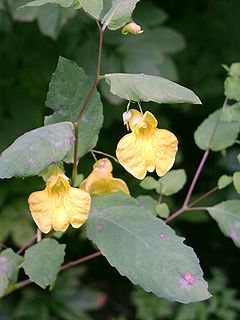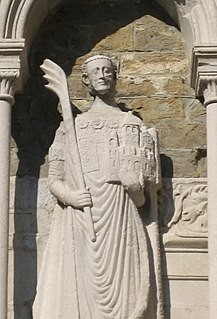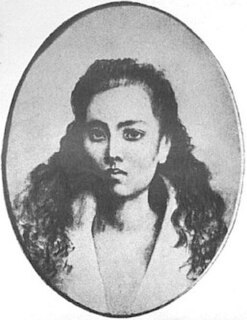
Noli Me Tángere is an 1887 novel by José Rizal during the colonization of the Philippines by the Spanish Empire, to describe perceived inequities of the Spanish Catholic friars and the ruling government.

Noli me tangere is the Latin version of a phrase spoken, according to John 20:17, by Jesus to Mary Magdalene when she recognized him after his resurrection. The biblical scene gave birth to a long series of depictions in Christian art from Late Antiquity to the present. The original Koine Greek phrase, Μή μου ἅπτου, is better represented in translation as "cease holding on to me" or "stop clinging to me", i.e. an ongoing action, not one done in a single moment.

Impatiens noli-tangere is an annual herbaceous plant in the family Balsaminaceae found in damp places in Europe, Asia and North America. The yellow flowers are followed by pods which forcefully explode when ripe, ejecting the seeds for some distance.

Adriaen van der Werff was a Dutch painter of portraits and erotic, devotional and mythological scenes. His brother, Pieter van der Werff (1661–1722), was his principal pupil and assistant.
The Cameroon soft-furred mouse or Cameroon praomys is a species of rodent in the family Muridae. It is found in Cameroon and Equatorial Guinea. Its natural habitat is subtropical or tropical moist montane forests. It is threatened by habitat loss.
Hibiscus dioscorides is a species of flowering plant in the family Malvaceae. It is found only in Yemen. Its natural habitat is rocky areas.
Hibiscus diriffan is a species of flowering plant in the family Malvaceae. It is found only in Yemen. Its natural habitat is rocky areas.
Hibiscus quattenensis is a species of flowering plant in the genus Hibiscus, in the family Malvaceae. It is found only in Yemen. Its natural habitat is subtropical or tropical dry shrubland.

Hibiscus scottii is a species of flowering plant in the family Malvaceae. It is found only in Yemen. Its natural habitat is subtropical or tropical dry forests.
Hibiscus socotranus is a species of flowering plant in the family Malvaceae. It is found only in Yemen. Its natural habitat is subtropical or tropical dry shrubland.

Hibiscus stenanthus is a species of flowering plant in the family Malvaceae. It is found only in Yemen. Its natural habitat is rocky areas.

Saint Justus of Trieste is a Roman Catholic saint.

María Clara, whose full name is María Clara de los Santos, is the mestiza heroine in Noli Me Tángere, a novel by José Rizal, the national hero of the Republic of the Philippines. Her name and character has since become a byword in Filipino culture for the traditional, feminine ideal.

La Vie is a 1903 oil painting by Pablo Picasso. It is widely regarded as the pinnacle of Picasso's Blue Period.

The Noli me tangere casket was a small silver-gilt casket made in 1356 for the Aachen Cathedral Treasury. It measured 15.2 cm in length, 3.7 cm in height and 4.8 cm in width. The casket was kept in the Marienschrein together with the key relics of the cathedral until the nineteenth century and the casket remained in the possession of the cathedral treasury until its destruction during the Second World War.

The Meister des Göttinger Barfüßeraltars was a Gothic German painter in Göttingen known for the creation of a large altarpiece in the Franciscan Church there in 1424. Although the church was demolished in around 1824, the altarpiece can be seen in the Lower Saxony State Museum in Hanover. The painting is 7.87 meters wide and 3.06 meters high, the largest preserved Gothic altarpiece in Lower Saxony (Niedersachsen). It was restored in 2005 after six years of work at a cost of 1.2 million euros.

The Magdalenenkirche or St. Magdalenen is one of the churches in Hildesheim, Lower Saxony, Germany. The Magdalenenkirche is a Catholic church that was once a monastery church, and is situated in the old town at 25 Mühlenstraße.

Barbara Baert is a Belgian art historian, and professor of art history at KU Leuven.

Noli Me Tangere is an opera in 3 acts by Felipe Padilla de León with libretto by Guillermo Tolentino. The opera was closely based on a novel by José Rizal by the same name. The opera was sung entirely in Tagalog and is considered as the first full-length Filipino opera.
Gertrud Schiller was a German art historian, nurse, social pedagogue and Lutheran teacher of religion. Despite not having a doctorate in art history, she wrote what remains a standard work on Christian iconography. Schiller received an honorary doctorate from the Kirchliche Hochschule Berlin in 1979.














